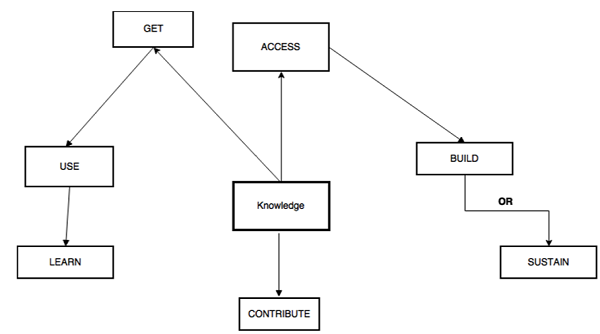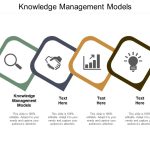Knowledge management cycle is a process of transforming information into knowledge within an organization. It explains how knowledge is captured, processed, and distributed in an organization. In this chapter, we will discuss the prominent models of knowledge management cycle.
Till date, four models have been selected based on their ability to meet the growing demands. The four models are the Zack, from Meyer and Zack (1996), the Bukowitz and Williams (2000), the McElroy (2003), and the Wiig (1993) KM cycles.
| Zack | Bukowitz & Williams | WIIG | McElroy |
| Acquisition | Get | Creation | Learning |
| Refinement | Use | Sourcing | Validation |
| Store | Learn | Compilation | Acquisition |
| Distribution | Contribute | Transformation | Integration |
| Presentation | Assess | Application | Completion |
Zack Knowledge Management Model
The Zack model is extracted from work on the design and development of information products. In Meyer and Zack’s approach, the network between each stage is designed to be logical and standardized.
In this cycle, the major developmental stages of a knowledge repository are analyzed and mapped to the stages of a KM cycle.
The stages are acquisition, refinement, storage/retrieval, distribution, and presentation/use. This cycle is also known as the “refinery.”
Acquisition of Data or Information
Acquisition deals with issues regarding origin of raw materials such as scope, breadth, depth, credibility, accuracy, timeliness, relevance, cost, control, and exclusivity.
The guiding principle is the well- known proverb of “garbage in, garbage out.” That is, highest quality source data is required, else the intellectual products produced downstream will be lower.
Refinement
Refinement may be physical (like migrating from one medium to another) or logical (like restructuring, relabeling, indexing, and integrating.)

Refining also defines cleaning up (like sanitizing content so as to ensure complete anonymity of sources and key players involved) or standardizing (like conforming to templates of a best practice or lessons learned as used within that particular organization).
This stage also adds up to the value by creating more readily usable knowledge objects and by storing the content more flexibly for future use.
Storage / Retrieval
Storage or Retrieval forms a bridge between the upstream addition and refinement stages that feed the repository and downstream stages of product generation. Storage can be physical (file folders, printed information) as well as digital (database, knowledge management software).
Distribution
Distribution defines how the product is to be delivered to the end-user (like fax, print, email) and encloses not only the medium of delivery but also its timing, frequency, form, language, and so on.
Presentation
Context plays an important role in Presentation or Application stage. The performance of each of the preceding value-added steps is evaluated here – for example, does the user have enough context to be able to make use of this content? If not, the KM cycle has failed to deliver value to the individual and ultimately to the company.
The repository and the “refinery” combined enable the management of valuable knowledge of a firm. In this cycle, there is also an impression of having to continually renew the repository and the refinery in order to avoid elimination.
The Meyer and Zack model is one of the most complete picture of the key elements engaged in the knowledge management model. To be specific the notion of refinement is a crucial stage in the KM cycle and one that is often neglected.
Bukowitz & Williams Model
Bukowitz and Williams portray a knowledge management process framework that outlines “how organizations generate, maintain and expand a strategically correct stock of knowledge to create value”.
In this framework, knowledge includes knowledge repositories, relationships, information technologies, communications infrastructure, functional skill sets, process know-how, environmental responsiveness, organizational intelligence, and external sources.

These stages aim on more long-range processes of matching intellectual capital to strategic needs.
● Get Stage is the first stage, it consists of seeking out information required in order to make decisions, solve problems, or innovate.
● Use Stage is the next stage, and it deals with how to combine information in new and interesting ways in order to foster organizational innovation. The spotlight is primarily on individuals and then on groups.
● The Learn Stage points to the formal process of learning from experiences as a means of creating competitive gain. Learning in enterprises is important because it serves the transition step between the application of ideas and the generation of new ones.
● The Contribute Stage of the Knowledge Management cycle deals with encouraging employees to post what they have learnt to the communal knowledge base (like a repository). Only in this way, can individual knowledge be made visible and available to the entire organization, where and when appropriate.
McElroy Model
McElroy outlines a knowledge life cycle that consists of the processes of knowledge production and knowledge integration, with a series of feedback loops to organizational memory, beliefs, and claims and the business-processing environment.
● Problem claim formulation is an attempt to learn and state the specific nature of the detected knowledge gap.
● Knowledge claim formulation acts as a response to approved problem claims via information acquisition and individual and group learning.
● New knowledge claims are tested and examined through knowledge claim evaluation processes.
● Evaluation of knowledge claims results in surviving knowledge claims that will be integrated as new organizational knowledge or falsified/undecided knowledge claims.
Experience gained from the application of knowledge in the organizational knowledge base leads to new claims and resulting beliefs, triggering the cycle to begin all over again.
In knowledge production, the primary processes are individual and group learning. Knowledge claim formulation, information acquisition; codified knowledge claim and knowledge claim evaluation.

These knowledge production processes can be briefed as −
● Individual and group learning marks the first step in organizational learning.
● Knowledge claim validation includes codification at an organizational level.
● A formalized procedure is essential for the receipt and codification of individual and group innovations.
● Information addition is the process by which an organization deliberately or serendipitously acquires knowledge claims or information produced by others, usually external to the company. This stage plays a basic role in formulating new knowledge claims at the organizational level.
Knowledge integration is the process by which an organization announces new knowledge claims to its operating environment and retires old ones. It includes all knowledge transmission such as teaching, knowledge sharing, and other social activities that either connects an understanding of previously produced organizational knowledge to knowledge workers or accommodate newly minted knowledge.
One of the advantages of the McElroy cycle is the clear description of how knowledge is examined and a conscious decision is made as to whether or not it will be included into the organizational memory. The authorization of knowledge is a step that clearly differentiates knowledge management from document management. The KM cycle aims at processes to identify knowledge content that is of value to the organization and its employees
WIIG Model
WIIG highlights the three conditions that need to be present for an organization to conduct its business successfully.
● It must have a business (commodities/services) and customers.
● It must have resources (people, budget, and facilities).
● It must have the strength to act.
WIIG marks the major purpose of KM as an effort “to make the organization intelligent-acting by facilitating the creation, accumulation, deployment and use of quality knowledge.” WIIG’s KM cycle shows how knowledge is built and used as individuals or as organizations.
The following figure shows the four major steps of the WIIG model.

● Building knowledge − From external and internal knowledge sources
● Holding knowledge − Storing the information in a particular form
● Pooling knowledge − Through intranets and knowledge management portals
● Applying knowledge − In the context of work embedded in process
Integrated Cycle
The following are the three major stages of integrated cycles of knowledge management strategy when introduced in any organization −
● Knowledge capture and/or creation
● Knowledge sharing and dissemination
● Knowledge acquisition and application

Knowledge Capture states the identification and frequent codification of existing (usually previously unnoticed) internal knowledge and know-how within the organization and/or external knowledge from the environment.
Knowledge Creation is the advancement of new knowledge and know-how innovations that did not have a previous existence within the organization.
Once, it is clear that the newly identified content is of sufficient value, the next step is to contextualize this content. This involves maintaining a connection between the knowledge and those knowledgeable about that content.
Contextualization also indicates identifying the key elements of the content in order to better match to a variety of users. Finally, contextualization succeeds to when the new content is firmly, precisely yet seamlessly, embedded in the business processes of the enterprise.
The knowledge management cycle is then rechecked as users understand and decide to make use of content.
The users will update usefulness, and they will signal when it becomes out of date or when this knowledge is not applicable.


